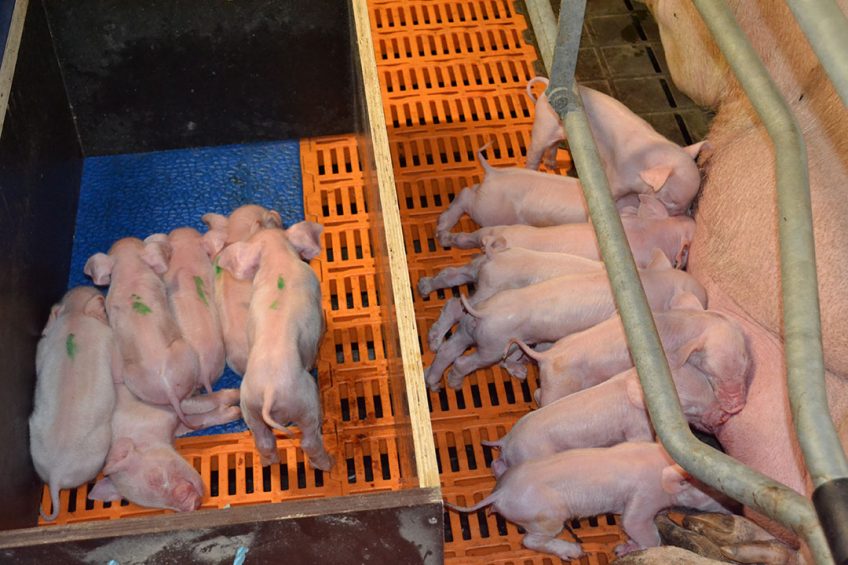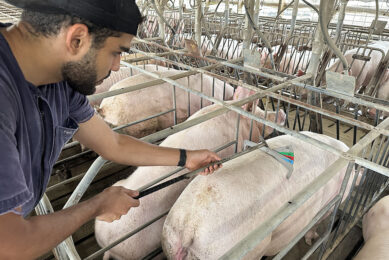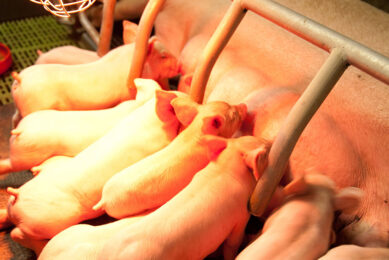Improving the chances of piglet survival

With sows getting increasingly more prolific, the cases of pre-weaning mortality are also growing. There are ways to make sure that the majority of underweight piglets get enough to allow them to catch up with the rest of the litter. A good strategy involves nesting, nurse sows and cross-fostering.
The period from birth until weaning is one of the most dangerous in a pig’s life, with pre-weaning mortality in most InterPIG countries now over 10%; that is, more than 1 in 10 pigs born alive dies before weaning. This is significant not only because of the related financial costs, but because of associated animal welfare concerns and the ethical and environmental issues surrounding production of piglets who are likely to die. The large increase in average litter size which has occurred during the past 20 years – in 2020 average born alive is now greater than 14 in 10 of the InterPIG countries, with a high of 17.5 in Denmark – means that more piglets are being born lighter, and thus it is increasingly important that care is taken to reduce the risk and proportion of pre-weaning mortality.
To improve the pigs’ chances of survival, it is useful to go back to basics and consider their biology. Historically most research, and the technological and genetic advances that have ensued, has focused on the physical performance of the animals; however, consideration of the pigs’ normal, instinctive behaviour, and efforts to satisfy this, can provide additional tools to add to the armoury in optimising piglet welfare and survival.
Creating a nest
For starters, as the due date approaches, the sow should be provided with material that will satisfy her motivation to create a nest. It has been demonstrated time and again that the instinct to create a nest during the 24 hours before farrowing is hardwired into the sow; in fact, the scientist who led much of the ground-breaking work identifying this fact, Professor David Wood-Gush, started his career as a geneticist.
Providing the sow with material she can tear up and use to imitate the process of creating a nest will lower her stress levels, speed up the farrowing process and consequently improve the chances of her piglets being born alive.
The next step is absolutely crucial; piglets need to consume as much colostrum as they can, ideally from their own mother, during the first day of life. After this they can no longer absorb the immunoglobulins. If litters are very large, it can be beneficial to supervise the tail end of the farrowing in particular and use a split suckling strategy to allow later-born piglets to get to a teat without competition from their older siblings.

Once piglets have had a chance to consume colostrum, the next challenge is ensuring that they all have access to their own functional teat for the rest of lactation. Although nursing bouts appear to go on for several minutes, milk let-down may only last for up to 30 seconds, so it could be easy for a piglet to miss out if not latched on quickly enough. The establishment of the teat order during the first few days after birth helps piglets to maximise their chances of obtaining milk during every nursing bout.
Piglets fight with each other to get at preferred teats, and after a couple of days each has their own. Once the order is determined fighting dies down; from then on nursing bouts can be devoted to feeding rather than fighting.
Unfortunately, selection for increased teat number has not kept pace with litter size, so if all piglets were left with their mother, fighting over teats would continue longer into lactation, and not all piglets would take in milk at every nursing bout. For that reason, cross-fostering and nurse sow strategies are often used.
Cross-fostering vs nurse sow strategies
It is important to define the terms and draw a distinction between “cross-fostering” and “nurse sow” strategies.
Cross-fostering: Piglets are selected individually from a litter for a variety of reasons (too many born alive, small piglets, lots of weight variation in the litter, etc.) and then placed onto another sow wherever there is space for them. This sow is often part of the same farrowing batch and has more teats available than piglets. Cross-fostering can occur at any stage throughout lactation, although usually during the first week. A piglet may end up being cross-fostered several times if care isn’t taken to monitor piglet movement.

Nurse sow strategies: This is a highly structured method of cross-fostering. In this case piglets are not moved individually to an already established litter; rather, enough piglets are moved to form an entirely new litter, and these are kept together as a group after movement. The nurse sow is not a sow within the same farrowing batch, but one that is further into her lactation (e.g. one week to four weeks). Her own piglets are either weaned off, or else moved to another nurse sow which is further again into lactation. Piglets are selected for movement at between 12 and 24 hours of age (after they’ve had colostrum from the mother), then a group of 12–14 moved simultaneously onto the nurse sow. The nurse sow will then rear the new litter as if it were her own.
The ones that move
A few years ago Teagasc carried out some research into nurse sow strategies, led by Dr Océane Schmitt. She carried out detailed behaviour observations of what happens after piglets are moved. When 24-hour-old piglets were moved to a nurse sow, there was intense fighting at nursing during the first few days. This was associated with piglets completely missing nursing bouts, until the teat order was formed about one week later.
Indeed, it is known that when piglets are moved to a new litter where there are resident piglets, fighting increases and is mostly between resident piglets and newly introduced ones. Interestingly, we also found that when 7-day-old piglets are all moved together to a new nurse sow, there was an increase in the number of teat changes (when piglets move from one teat to another during nursing). This suggests that the teat order that the piglets established when with the first sow (before movement) was disturbed even by the transfer onto the nurse sow. This highlights again that piglets should be moved as little as possible.

The ones that are left behind
Dr Schmitt also observed the piglets that were left behind on the mother sow after the extra ones were moved to a nurse sow. She used sows that had more than 14 piglets born alive, and 24 hours after birth moved enough piglets so that only 12 were left behind with the mother. Here, we found benefits for the piglets that were left behind; these performed fewer teat changes after the extra piglets were taken away. We moved the larger piglets from each litter, because these ones would be better able to adjust to moving to a new sow. By the time of weaning, the small piglets that had been left with the mother sow had caught up with the bigger piglets that were moved, so that their weights were the same. This is an obvious advantage at weaning, as it makes it easier to form groups of similarly sized pigs.
Cross-fostering throughout lactation
In the nurse sow studies, cross-fostering after 24 hours was only carried out if there was a piglet starving or at risk of dying. After these piglets were moved, their growth continued to be monitored until weaning. Piglets that were very light at birth (in the lightest 20%) were cross-fostered on average about ten days into lactation, whereas for the rest it was about 17 days in.
Average daily gain (ADG) for the very light piglets did not improve after cross-fostering, and in fact about 30% of them died anyway. However, for piglets that were heavier at birth, average daily gain improved after cross-fostering and only 13% died. This shows that for piglets that are born a normal weight, but for some reason do not thrive in early lactation, there is a benefit in moving them to a new sow. However, for the lighter piglets, the benefit is not as obvious.
Besides the work with nurse sows, Teagasc has also carried out work on commercial farms where cross-fostering was carried out routinely by farm staff. In this situation piglets were not necessarily cross-fostered due to starvation or risk of dying, but the focus was also on evening up litters and matching piglet sizes.
From one study, the Teagasc team found that nearly 20% of pigs were cross-fostered more than once, and that that was associated with a greater risk of pre- and post-weaning mortality, pericarditis and heart condemnations. These are likely related to ongoing fighting and exposure to new pathogens at every move.
In another commercial study the team investigated how cross-fostering affects growth. On that farm 44% of piglets were fostered at least once, and these were representative of all birthweights. ADG was reduced by 21g/day for cross-fostered piglets, resulting in them being about 550g lighter than non-fostered piglets at weaning. Worryingly, these differences were greatest in piglets that were the heavy ones at birth. For the lightest 20% of piglets, cross-fostering had no effect, positive or negative, on ADG or weaning weight.

Take-home points
- Movement of piglets should ideally be carried out only once, after the piglet has had colostrum from the mother (approximately 24 hours after birth);
- Cross-fostering medium to heavy piglets is associated with lower ADG and weaning weights. Thus it should only be carried out if the litter is too large for the mother to rear herself, or if the piglet is at risk of starvation;
- Tagging very light piglets at birth, and any piglet that is moved, will aid in identifying them later on. If there’s a small/light piglet with a tag in a litter, producers will know it was always small, so unless it looks like it is starving there’s no benefit to moving it. If it has no tag, producers will know it was born a normal weight, so is experiencing a growth check and may benefit from being moved.
This article is a summary of a webinar given in the Tonisity series during the digital EuroTier 2021, held in February 2021. The webinar can be viewed on the company’s website.
Author:
Dr Keelin O’Driscoll, Teagasc, Ireland











